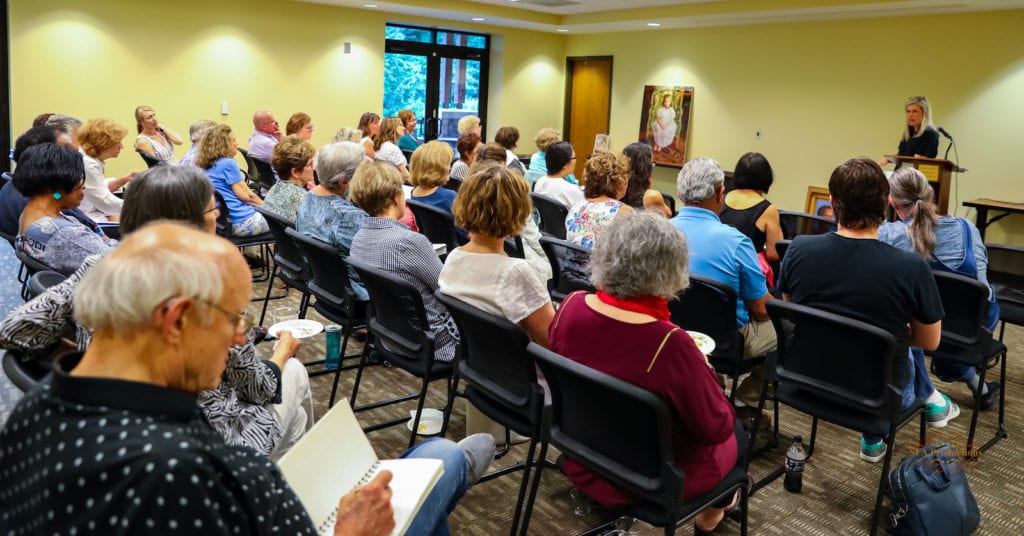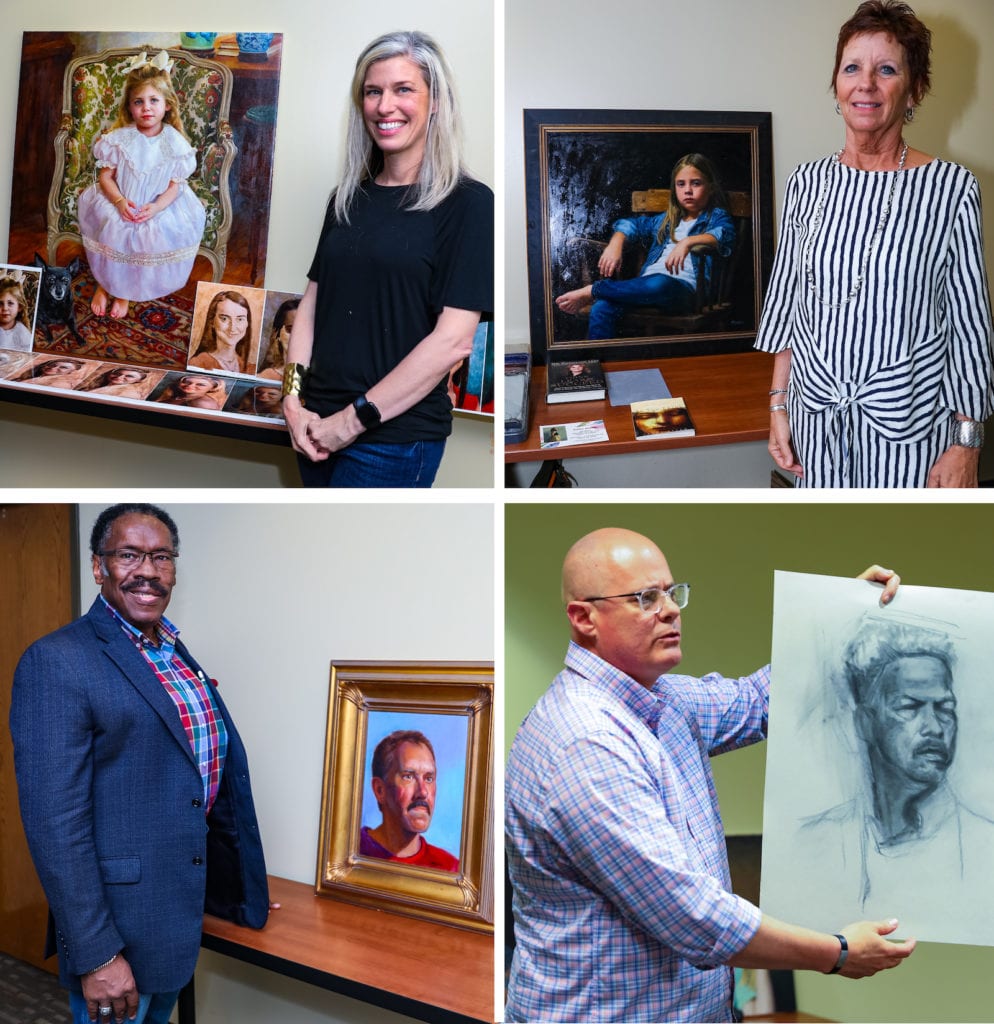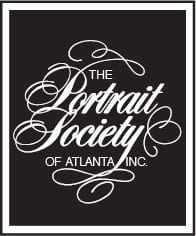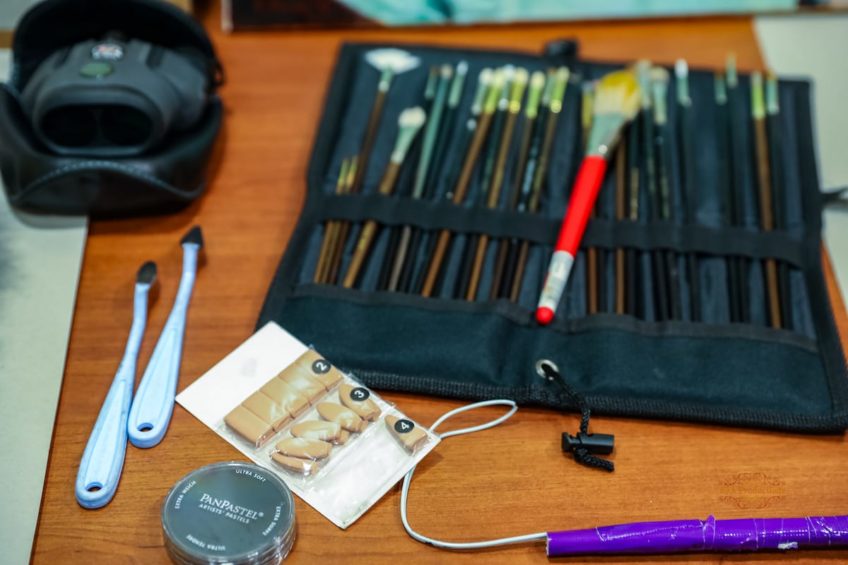By Margaret Ann Garrett
Recently, four of the Portrait Society of Atlanta’s own exhibition winners shared bits of their working processes. At the May meeting, Holly Henson, Kathy Morris, Eric Nyros, and Ernest Varner shared insights—both technical and psychological—which they’ve found useful. Here are some highlights from the presentations.
 For her portrait commissions, Holly Henson has found that positioning the camera on a tripod and using a remote clicker helps her maintain eye contact and communication with the subject. She also pre-plans her photo sessions by having the family send photographs of the house, or location, in advance. She then pre-selects two to three locations for the photo shoot. In these instances, because she isn’t painting directly from life, she makes color notes of skin tones, and aspects of the environment, on a canvas for later reference.
For her portrait commissions, Holly Henson has found that positioning the camera on a tripod and using a remote clicker helps her maintain eye contact and communication with the subject. She also pre-plans her photo sessions by having the family send photographs of the house, or location, in advance. She then pre-selects two to three locations for the photo shoot. In these instances, because she isn’t painting directly from life, she makes color notes of skin tones, and aspects of the environment, on a canvas for later reference.
Henson prefers painting on an oil-primed linen adhered to a hard surface, but for larger work, she uses stretched canvas. In her indirect painting method, she first underpaints with an ébauche or grisaille. Claiming to be a “really slow painter,” Henson says you must have faith in the indirect process—as nothing looks right until the end.

Among her awards, Kathy Morris was most recently a finalist in the 14th International Art Renewal Center (ARC) Salon (2019-2020). For her working method, she prefers to use a parallel palette so that her colors are seen in the same light as the canvas. And she typically uses a limited color palette and finds small brushes most useful for her style. Following her father’s advice to always use good tools, she uses the best quality supplies. Her painting surface is one she prepares herself from 4’ x 8’ sheets of aluminum dibond, which she cuts and gessoes (four layers). For Morris, tools are just an extension of the mind, and thoughts can either limit or set you free. Your thoughts can also either catapult you forward or hold you back. She has read extensively on the neuroplasticity of the mind. Once afraid of failure and of not being good enough, she learned to reject negative mindsets and replace them with healthy thoughts. Morris attributes improvement in her work to an attitude of positivity and paraphrasing Vincent van Gogh—Morris advised, “If you hear a voice within you that says: you cannot paint….don’t listen, keep painting.”
In addition to being a Portrait Society of Atlanta First Place Award winner, Eric Nyros was a finalist this year in the same 14th International ARC Salon competition as Kathy Morris. His work has a deeply classical quality with rich colors and dramatic lighting. Nyros typically begins on a medium-toned canvas. Although his experience has been to work in a limited color palette of earth tones, he was recently advised to expand his colors. Aware of the importance of drawing, he works daily to deepen his already extensive ability and has recently been delving into using pan pastels with foam applicators of various sizes. Nyros has found them very useful in the way he sees and interacts with a drawing. Also, as an aid, in a life session he will use a small set of binoculars to clearly see small details. When lighting a subject, he uses a strong warm light source to achieve dramatic shadows, and he will make four or five passes of color in a piece. He finds a mahl stick invaluable and favors a soft fluffy brush to lightly brush the surface and blend colors when needed.
The last artist in the lineup is Ernest Varner, longtime member, past president, teacher, and humorist. He started out by saying that most of the tips he was going to share had already been mentioned. But despite that, he did cover some new territory.
-
- You don’t have to have 5,000 colors on your palette to make a beautiful painting: As long as it says what you want it to say, the number of colors isn’t important.
- While it’s critical to learn to work from life, photos are also important, because no one volunteers to sit for three hours for days on end.
- Don’t just practice until you get it right…practice until you can’t get it wrong.
- He encourages beginning students to “use” paint. He likes “paint to act like paint.”
- On brushes: “What is this ‘big’ brush thing? Just use the size that works!”
- Lean to paint more than faces. Backgrounds, landscapes, still life objects—are all necessary to paint well.
- We experience six steps in the creative process: 1) This is awesome, 2) this is tricky, 3) this is crap, 4) I am crap, 5) this might work, and 6) this is awesome.
- Set goals. Plan, execute, evaluate, and repeat.
Varner works on different surfaces—sometimes toned, sometime not—and prefers to feel the paint with no medium. When he was career military, the only time he had to paint was in the middle of the night and he sometimes still prefers to paint alone, where there is a silence—a wonderful silence.
In closing, he described the difference is between a Master and a Beginner: A master has failed more times than the beginner has tried.
To learn more about these members, visit:
Holly Henson at: http://www.holly-henson.com
Kathy Morris at: https://kathymorrisfineart.com
Eric Nyos at: https://ericnyrosfineart.com
Ernest Varner at: https://www.instagram.com/eevarner/
Photo credit: Vinod Sharma


